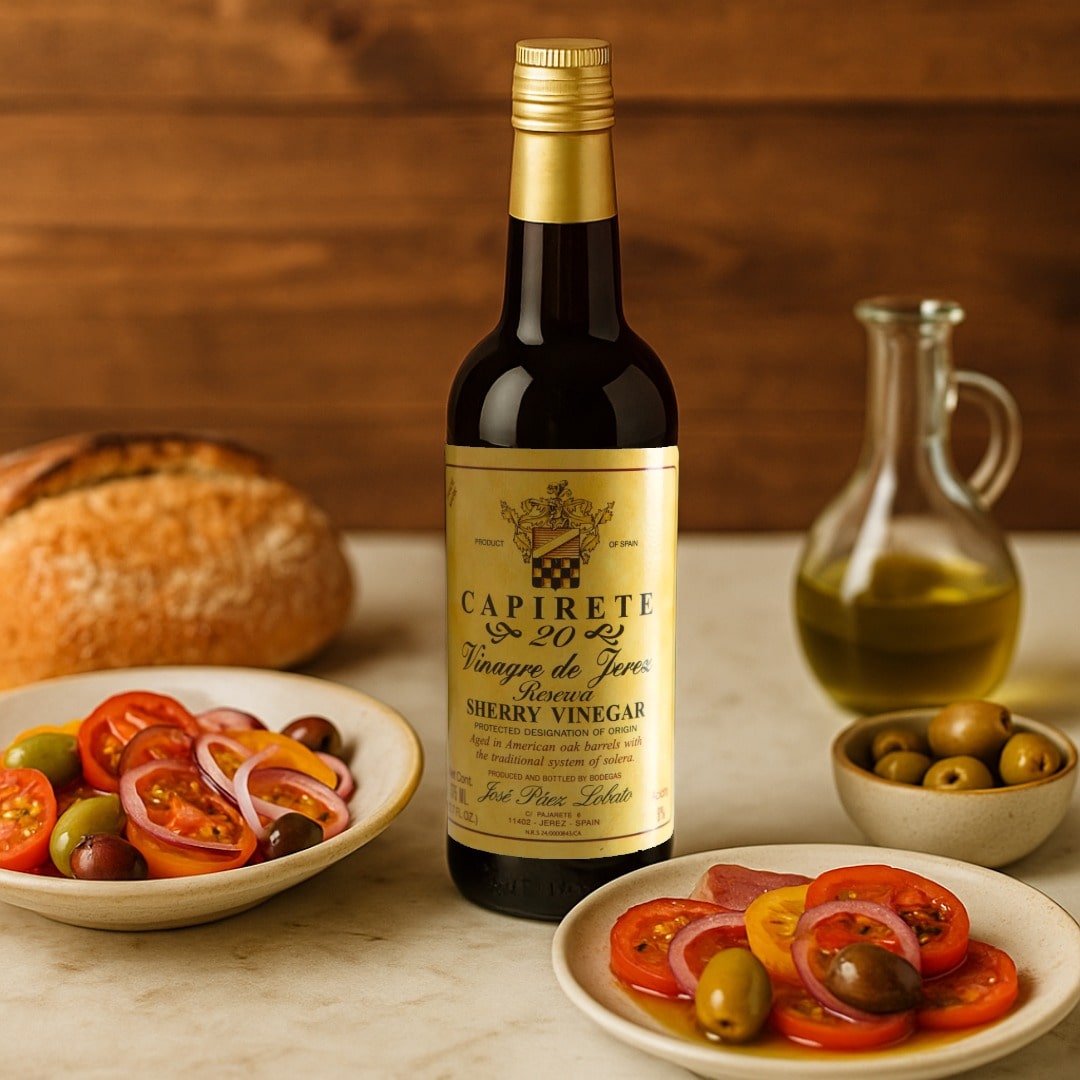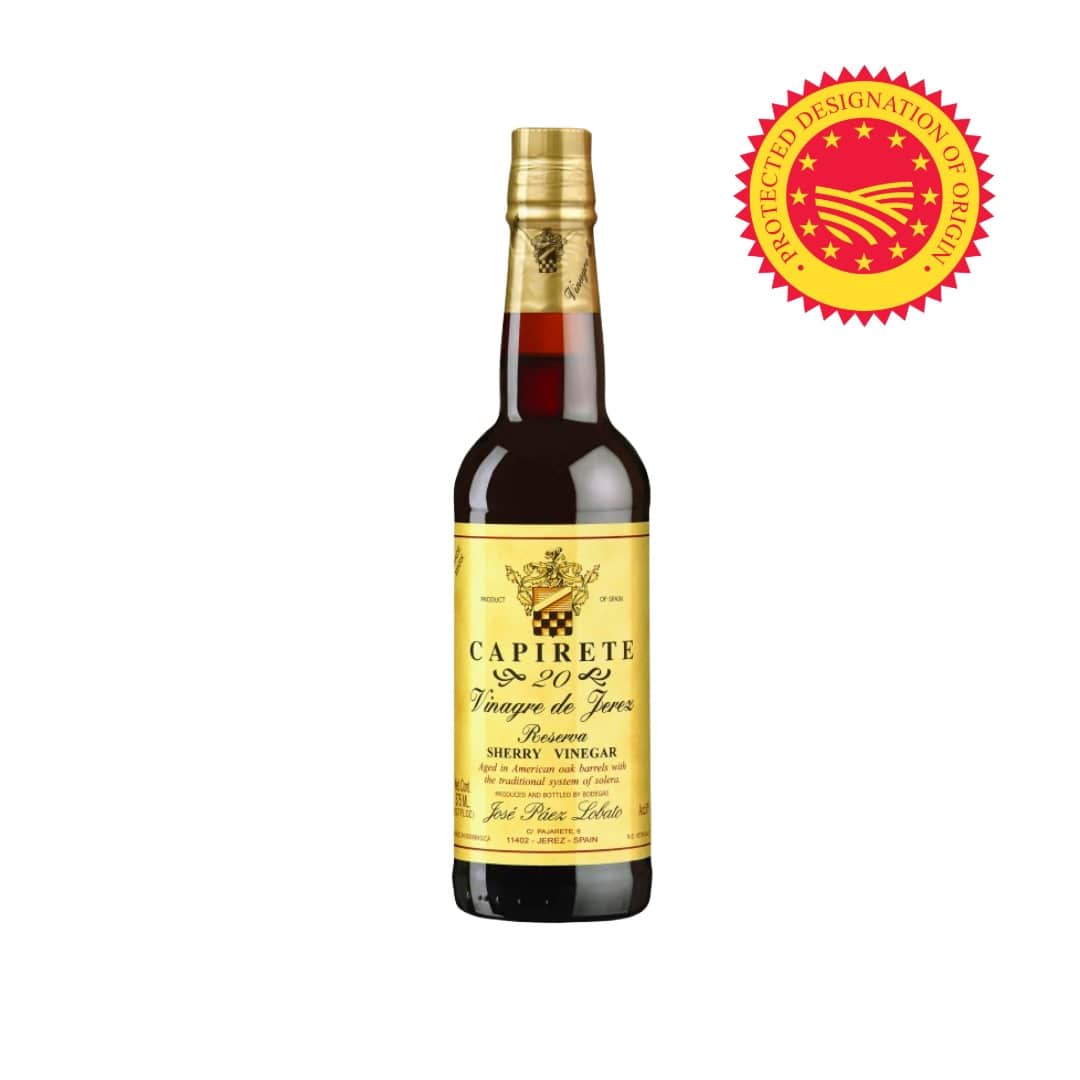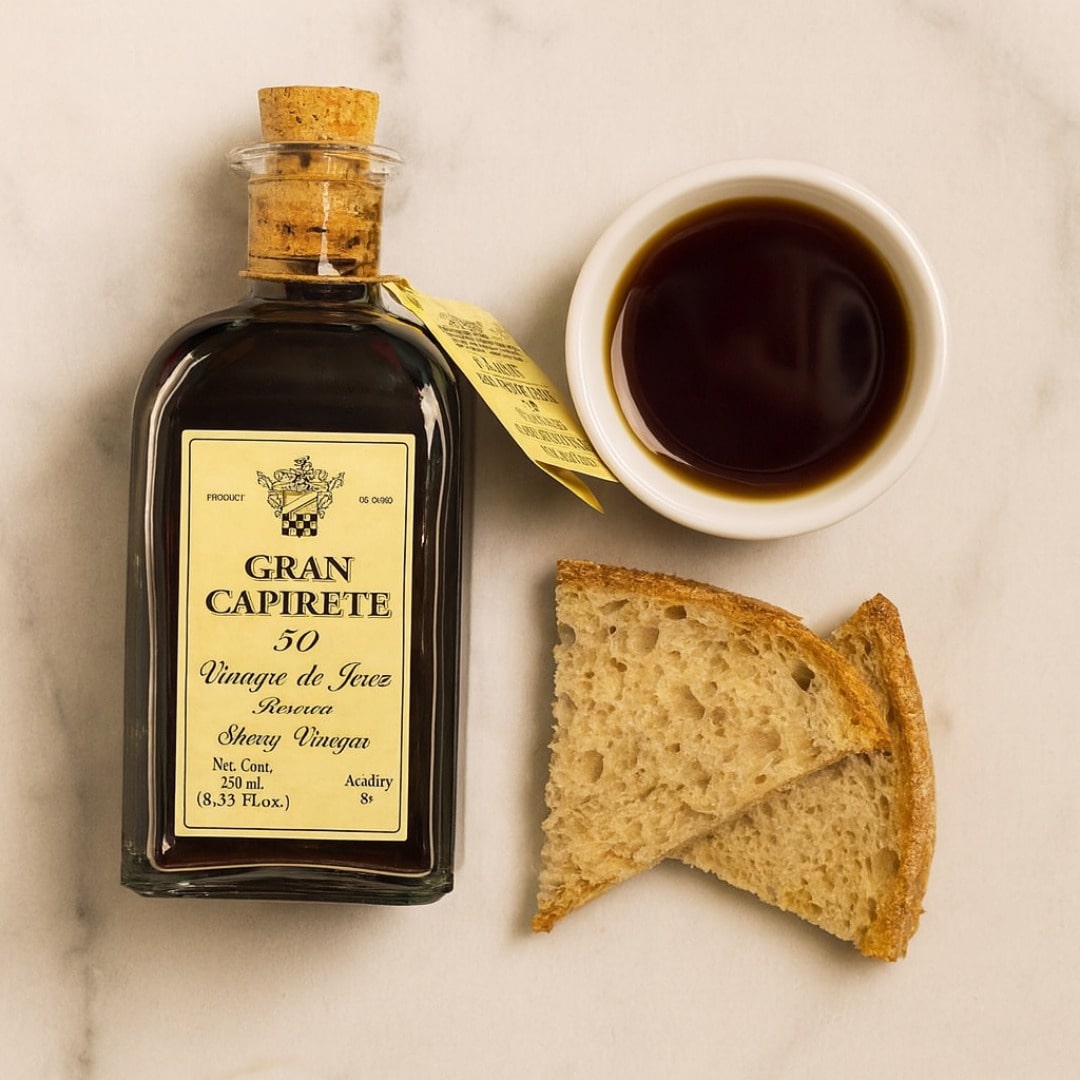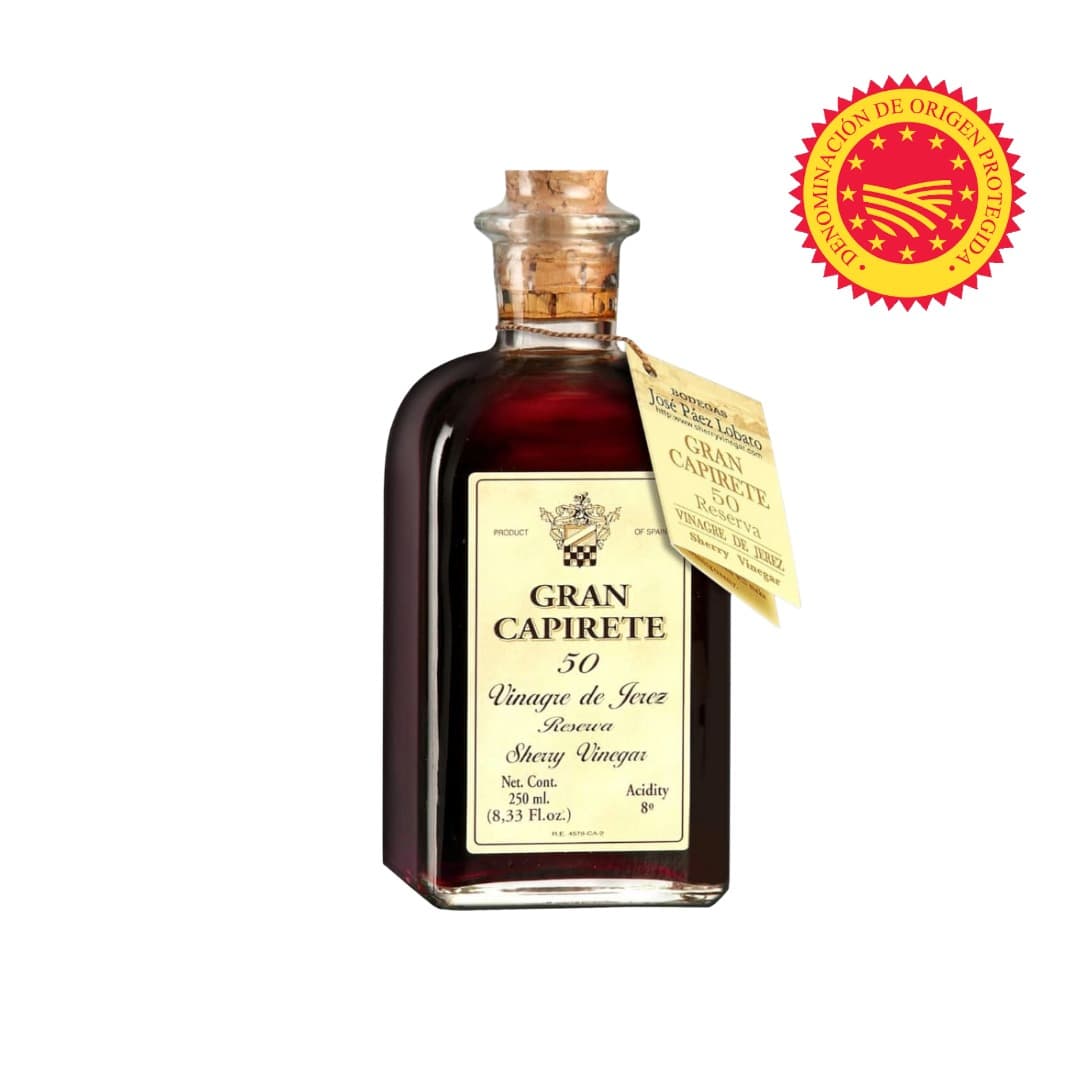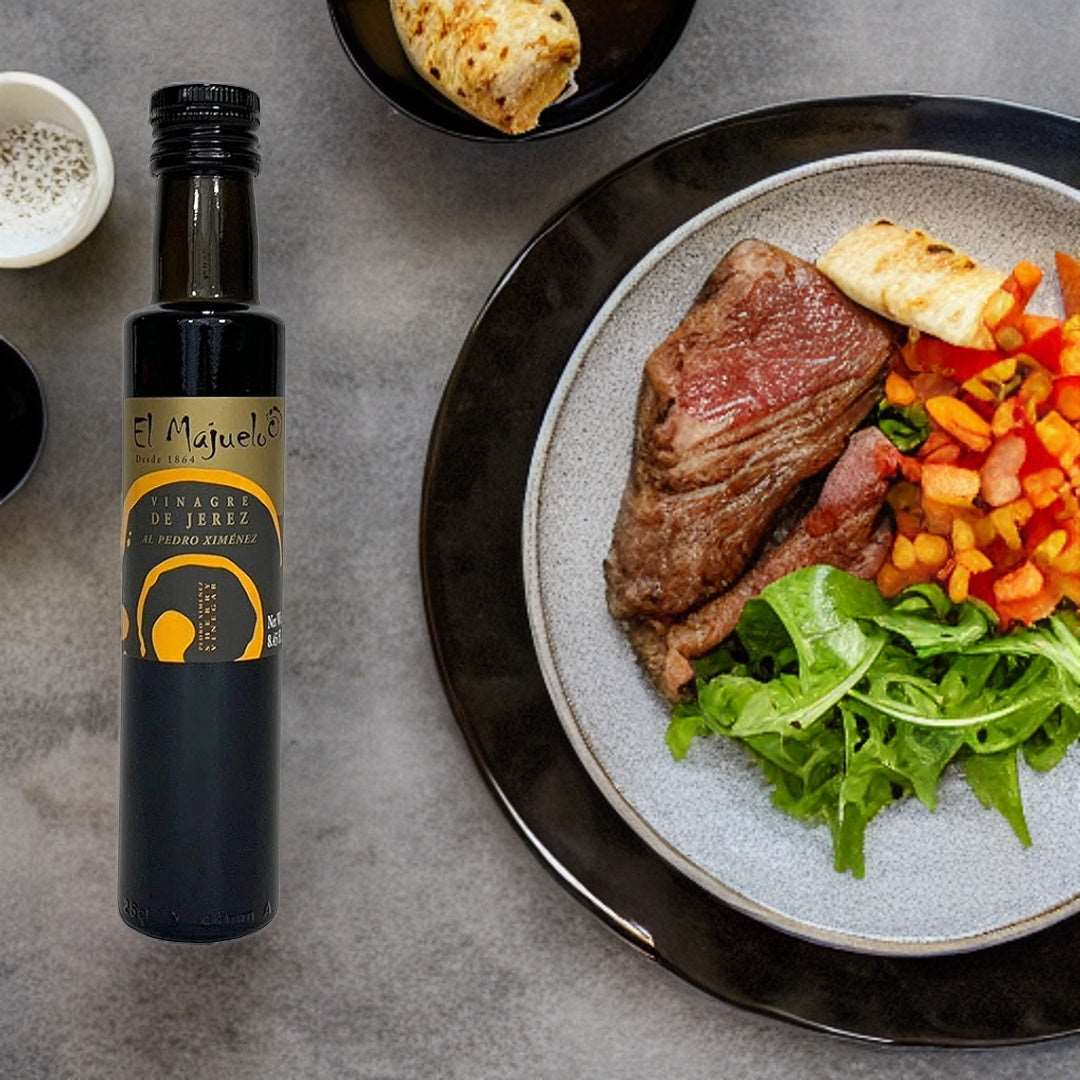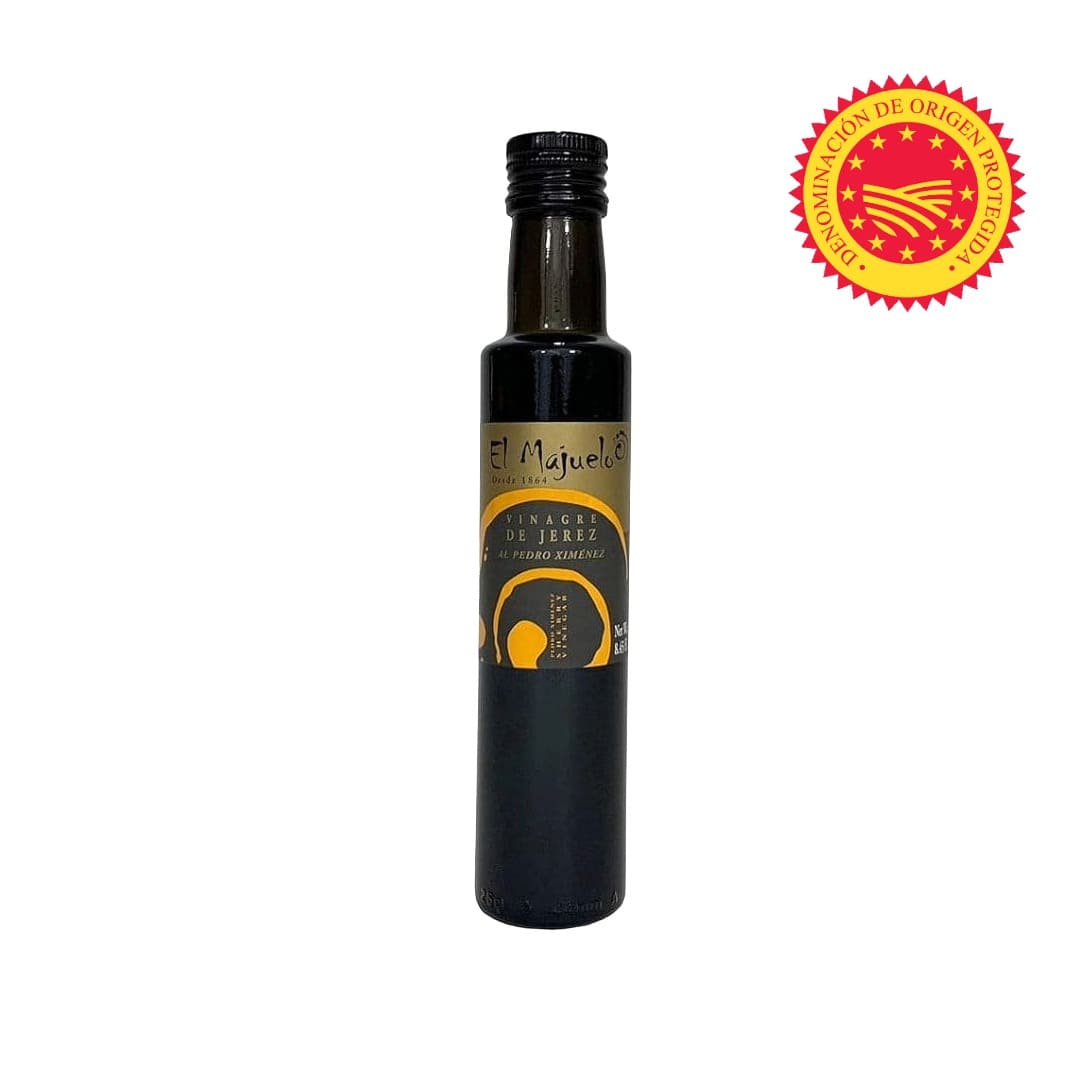3 products
3 products
Sort by:
Discover the Rich and Unique Flavor of 20-Year-Aged Sherry Vinegar
This Sherry Vinegar, aged for 20 years in American oak barrels using the traditional solera system, is an exceptional product from Jerez (Cádiz), in the heart of Andalucia, Southern Spain. Known in Spanish as "Vinagre de Jerez", this vinegar is exclusively produced in this region, benefiting from its unique climate. The hot and dry conditions, balanced by cool Atlantic breezes, the Mediterranean Sea, and the Guadalquivir River, create the perfect environment for vinegar production, resulting in a vinegar with concentrated acidity and a rich aroma.
There truly is no substitute for Sherry vinegar. Its complex flavor profile is unmatched, making it a must-have ingredient in your kitchen.
Why Choose Sherry Vinegar Aged 20 Years?
- Aged for 20 Years: Crafted using the traditional solera system and aged in American oak barrels, delivering a bold and complex flavor.
- Exclusive to Jerez: Produced exclusively in the Jerez region of Spain, where the climate and environment add unique characteristics to the vinegar.
- Concentrated Acidity and Aroma: The ideal conditions in Andalucia result in a vinegar with intense acidity and rich aroma, perfect for a variety of dishes.
How to Use Sherry Vinegar in Your Cooking
This gourmet Sherry vinegar is versatile and perfect for enhancing both simple and complex dishes:
- Seafood and Salads: Drizzle over seafood or salads for an added depth of flavor and tangy acidity.
- Soups and Dressings: Add to soups and dressings to bring out a robust and aromatic touch.
- Authentic Gazpacho: A must-have ingredient for making authentic Andalusian gazpacho—this vinegar adds the perfect balance of acidity to this iconic Spanish dish.
Tasting Notes – A Rich and Complex Sherry Vinegar
Palate: Intense acidity with a deep, complex flavor profile that reflects its 20-year aging process. Notes of oak and rich, wine-infused complexity dominate the palate.
Nose: A concentrated aroma of wine-soaked oak barrels, with a balance of sweet and tangy notes, making it perfect for gourmet cooking.
Buy Sherry Vinegar Aged 20 Years Online
Elevate your dishes with the exceptional flavor of Sherry Vinegar Aged 20 Years. Order online at Iberico Taste and enjoy fast, reliable shipping across the USA. Perfect for seafood, salads, dressings, and authentic Spanish gazpacho, this Vinagre de Jerez is a must-have for your kitchen.
Discover the Luxury of 50-Year-Aged Sherry Vinegar
The Gran Capirete Sherry Vinegar, aged for 50 years in American oak barrels using the traditional solera system, is a testament to the rich heritage of Vinagre de Jerez from Jerez (Cádiz) in Andalucia, Southern Spain. Crafted by Bodegas José Páez Lobato, a family business specializing in fine sherry vinegar for over 60 years, this vinegar offers an amber color, a delicate bouquet, and a flavor profile like no other.
Thanks to the unique climate of the region—hot and dry conditions tempered by cool breezes from the Atlantic Ocean, Mediterranean Sea, and the Guadalquivir River—this vinegar achieves a concentrated acidity and aroma that elevate any dish.
Why Choose Gran Capirete Sherry Vinegar?
- Aged for 50 Years: A rare sherry vinegar aged for half a century, delivering an unparalleled depth of flavor and complexity.
- Traditional Solera System: Produced using the solera system, ensuring consistency and high quality in every bottle.
- Exclusive to Jerez: Made in the heart of Jerez, where the region’s climate contributes to its rich flavor and refined characteristics.
- Crafted by Experts: Produced by Bodegas José Páez Lobato, a family-run business with over six decades of expertise in sherry vinegar production.
How to Use Gran Capirete Sherry Vinegar in Your Cooking
This luxurious Sherry vinegar is ideal for adding depth and complexity to a variety of dishes:
- Seafood and Salads: Drizzle over seafood or fresh salads for a tangy, complex flavor.
- Soups and Dressings: Perfect for adding acidity and richness to soups and homemade dressings.
- Authentic Gazpacho: An essential ingredient for making authentic Andalusian gazpacho, giving it the perfect balance of acidity.
Tasting Notes – A Refined and Aromatic Sherry Vinegar
Palate: This 50-year-aged vinegar offers a rich, concentrated acidity with a complex flavor profile, balanced by the deep, oaky notes imparted by its long aging process.
Nose: Aromatic with hints of amber and wood, delivering a delicate bouquet that reflects its meticulous preparation over decades.
Buy Gran Capirete Sherry Vinegar Aged 50 Years Online
Experience the luxury and refinement of Gran Capirete Sherry Vinegar Aged 50 Years. Order online at Iberico Taste and enjoy fast, reliable shipping across the USA. Perfect for seafood, salads, soups, and creating the most authentic gazpacho, this vinegar is a must-have for those who appreciate the finest ingredients.
Discover the Unique Flavor of Pedro Ximénez Sherry Vinegar
The Sherry Vinegar Pedro Ximénez is crafted from the Pedro Ximénez grape variety, offering a touch of sweetness that makes it a versatile condiment for any dish, including desserts. Produced using the traditional Criaderas and Soleras method, this vinegar is aged in oak barrels for a minimum of 2 years, which gives it a sweet and fresh flavor with lower acidity than other sherry vinegars.
With its extremely aromatic profile and soft texture, this vinegar enhances the flavor of every dish it accompanies. It’s an excellent choice for both sweet and savory dishes, adding complexity and balance.
Why Choose Pedro Ximénez Sherry Vinegar?
- Made from Pedro Ximénez Grapes: Known for their rich, syrupy sweetness, these grapes add a distinct sweetness to the vinegar.
- Traditional Criaderas and Soleras Method: Produced following artisan methods and aged in oak barrels for 2 years to develop its unique flavor.
- Sweet and Aromatic: A fresh, sweet vinegar with lower acidity, perfect for enhancing a variety of dishes, including desserts.
- Versatile in the Kitchen: Complements both sweet and savory dishes, adding a sophisticated touch.
What is Pedro Ximénez?
Pedro Ximénez (PX) is a variety of Spanish white grape known for its rich, sweet dessert wines. These wines, made from sun-dried grapes, are known for their syrupy sweetness and deep, dark flavors, often reminiscent of raisins, figs, and caramel. Pedro Ximénez grapes are commonly grown in the Jerez region of Spain, where they are used to make renowned fortified wines and vinegars like this one.
How to Use Pedro Ximénez Sherry Vinegar in Your Cooking
This sweet and aromatic vinegar is ideal for pairing with both sweet and savory dishes:
- Desserts: Drizzle over ice cream, fresh fruits, or cakes for a touch of sweetness and acidity.
- Cheeses: Perfectly complements aged cheeses like Manchego, adding a contrast of sweet and tangy flavors.
- Savory Dishes: Add depth to sauces, or use in salad dressings for a complex flavor profile.
Tasting Notes – A Sweet and Soft Sherry Vinegar
Palate: Sweet and fresh with notes of raisins and caramel, balanced by a lower acidity due to its aging process.
Nose: Rich and aromatic, with hints of oak from its time spent aging in barrels, delivering a delicate and complex aroma.
Buy Sherry Vinegar Pedro Ximénez Online
Enhance your dishes with the Sherry Vinegar Pedro Ximénez, offering a unique blend of sweetness and acidity that’s perfect for both desserts and savory dishes. Order online at Iberico Taste and enjoy fast, reliable shipping across the USA. Whether for cheeses, desserts, or adding a touch of luxury to your meals, this sweet and aromatic vinegar is a must-have in your kitchen.
Frequently asked questions if you want to buy Sherry Vinegar
What is Sherry Vinegar?
Sherry vinegar, or vinagre de Jerez, is a unique and complex ingredient hailing from Cádiz, Spain. Its rich history and distinct production methods make it a staple in many culinary traditions. From the solera aging system to the different grape varieties used, sherry vinegar offers a spectrum of flavors. This article explores its origins, types, and versatile uses in the kitchen, including five easy recipes.
The History and Origin of Sherry Vinegar
Sherry vinegar's rich history is deeply intertwined with that of Sherry wine. Originating in Cádiz, Spain, its evolution from wine to vinegar marks a fascinating journey.
The roots of Sherry vinegar are deeply planted in the centuries-old tradition of Sherry wine production in the province of Cádiz, Spain. Sherry wine itself is a famed product with a long-standing history, praised for its unique aging process and diverse flavor profiles. The same methods and principles that give Sherry wine its characteristics are also applied to Sherry vinegar.
Initially, the creation of Sherry vinegar was unintentional, the result of wine undergoing acetic fermentation and becoming vinegar. Early bodegueros, or winemakers, viewed this process as a failure. Despite this, the accidental creation of Sherry vinegar did not go unnoticed for long, as it soon began to be recognized for the distinctive flavors it brought to the table.
Production Process: Criaderas and Soleras System
The Solera system, a dynamic aging and blending process, is crucial for Sherry vinegar. Barrels are arranged in tiers, known as criaderas. Vinegar is periodically transferred through these tiers, mixing younger vinegar with more mature stocks. This process ensures consistent quality and flavor.
The aging stage is pivotal, occurring in American oak barrels. The vinegar matures over time, absorbing the wood’s nuances, acquiring depth and complexity. Aging periods vary, contributing to different classifications of Sherry vinegar.
Types of Sherry Vinegar based on aging process
The classification of sherry vinegar is based on its aging process and duration, offering a range of complex flavors and aromas.
Sherry Vinegar
Sherry Vinegar is the most basic type, aged for a minimum of six months in oak barrels. This aging period, although relatively short, allows the vinegar to develop an initial depth of flavor characterized by its bright acidity and subtle oaky notes. Sherry Vinegar is often used as a versatile ingredient in culinary applications where it adds a tangy yet refined touch.
The aroma is typically sharp and pungent, with undertones of dried fruits and nuts. This type of vinegar is well-suited for dressings, marinades, and sauces, where its robust character can infuse dishes with a distinct and sophisticated flavor.
Sherry Vinegar Reserva
Sherry Vinegar Reserva undergoes a more extended aging process of at least two years in oak barrels. This prolonged aging allows the vinegar to develop greater complexity and a deeper, richer flavor profile. The extended contact with oak imparts notes of caramel, toasted nuts, and a mellower acidity compared to the basic Sherry Vinegar.
The color of Sherry Vinegar Reserva is typically darker, often showing a deep amber hue. This type is ideal for dishes that benefit from its enhanced depth, such as hearty stews, robust sauces, and slow-cooked dishes. Its nuanced flavors make it a favorite among chefs for elevating both simple and elaborate recipes.
Sherry Vinegar Gran Reserva
Sherry Vinegar Gran Reserva represents the pinnacle of sherry vinegar production with an aging period of over ten years. This extended aging process results in a vinegar with exceptional depth and complexity, featuring a symphony of flavors that evolve with each taste. Notes of caramel, dried fruits, and balsamic richness are prevalent, along with a very smooth and balanced acidity.
The appearance of Sherry Vinegar Gran Reserva is much darker, often approaching the color of mahogany. Its texture is also thicker and more syrupy due to the concentration of flavors over the long aging period. This vinegar is a luxurious addition to gourmet dishes, where its profound flavor can shine. It is often used sparingly to add a touch of elegance and sophistication to premium recipes, including fine sauces, reductions, and special marinades.
Varieties Based on Grape
Different grape varieties give sherry vinegar its unique range of flavors and characteristics. This section explores the three main types of sherry vinegar based on the grapes used in their production.
Palomino Vinegar
Palomino is the most commonly used grape variety in the production of sherry vinegar. Originating from the Palomino Fino grape, which is also used for making many sherry wines, this vinegar offers a distinctive sharp and nutty flavor profile.
Palomino vinegar is typically characterized by its dryness and balanced acidity. The flavors are less sweet compared to other types, making it a versatile ingredient in various culinary applications.
Because of its relatively neutral but complex taste, Palomino vinegar works well in vinaigrettes and marinades, enhancing the flavors of fresh salads and roasted meats without overpowering them.
Pedro Ximénez Vinegar
Pedro Ximénez, often abbreviated as PX, is known for producing some of the richest and sweetest sherry wines, and this translates directly into the vinegar made from this grape. PX vinegar is marked by its dark color and syrupy consistency.
The aging process often brings out intense flavors reminiscent of raisins, figs, and caramel. This makes PX vinegar an excellent choice for dishes that benefit from a touch of sweetness.
PX vinegar is particularly well-suited for drizzling over grilled vegetables, adding depth to sauces, or even being used as a reduction to accompany desserts like vanilla ice cream or fresh fruit.
- Sweet and syrupy with rich flavors of dried fruit
- Dark color and thick consistency
- Ideal for finishing dishes and as a dessert enhancer
Moscatel Vinegar
Moscatel vinegar, derived from the Moscatel grape, is less common than Palomino and PX varieties but offers a unique and aromatic profile. The Moscatel grape is known for its fragrant and floral qualities, which carry over into the vinegar.
This vinegar tends to be sweeter and lighter, with pronounced floral and fruity notes. The complexity of Moscatel vinegar makes it a fantastic addition to delicately flavored dishes that benefit from a hint of sweetness and aroma.
Some popular uses for Moscatel vinegar include pairing it with seafood, using it in light summer salads, and adding it to fruit-based sauces or reductions.
- Sweet, light, and aromatic
- Floral and fruity notes
- Great for seafood and light delicate dishes
Sherry Vinegar vs. Balsamic Vinegar
Sherry vinegar and balsamic vinegar, while both beloved in culinary circles, differ significantly in taste, origin, and production methods.
Origin: Sherry vinegar is made in the Cádiz region of Spain, particularly within the "sherry triangle." Balsamic vinegar, specifically Aceto Balsamico Tradizionale, originates from Modena or Reggio Emilia in Italy.
Grape Varieties: Sherry vinegar typically comes from Palomino, Pedro Ximénez, or Moscatel grapes. Balsamic vinegar is made from Trebbiano and Lambrusco grapes.
Production Method: Sherry vinegar undergoes a solera aging system, which involves blending older and younger vinegars in oak barrels. True balsamic vinegar is produced from grape must that is concentrated and then aged for a minimum of 12 years in a series of progressively smaller barrels made of different woods.
Sweetness and Acidity: Balsamic vinegar is known for its sweet, rich, syrupy taste and moderate acidity. In contrast, sherry vinegar has a higher acidity with flavors of nuts and dried fruits and less sweetness, making it more versatile for savory dishes.
Price Point: Authentic Aceto Balsamico Tradizionale can be quite expensive, sometimes over $200 for a small bottle, whereas high-quality sherry vinegar is generally more affordable, often less than $10 per bottle.
Sherry Vinegar vs. Red Wine Vinegar
When comparing sherry vinegar to more commonly used wine vinegars, several key differences emerge in both flavor and application.
Flavor Profile: Sherry vinegar boasts a layered, complex taste with nutty, caramel, and dried fruit notes due to the aging process. Wine vinegars, whether red or white, tend to have a straightforward acidic flavor without the depth found in sherry vinegar.
Aging Process: Sherry vinegar, aged through the solera system, gains complexity over time as older and younger vinegars mix. Wine vinegars generally do not undergo such elaborate aging and are often bottled shortly after fermentation and acetification.
Versatility in Cooking: Sherry vinegar's nuanced flavors make it suitable for a wide array of dishes, from vinaigrettes and marinades to soups and reductions. Wine vinegars, while useful in many recipes, lack the distinctive character that makes sherry vinegar stand out in gourmet cooking.
Acidity Levels: Sherry vinegar usually has a minimum of 7 degrees of acidity, offering a more pronounced sharpness. Wine vinegars, while also acidic, typically have a less intense tartness.
Cost and Availability: Both vinegars are widely available, but sherry vinegar offers an affordable luxury with its sophisticated taste, while wine vinegars are the go-to option for everyday cooking due to their simplicity and lower cost.
Sherry Vinegar vs Cooking Wine
Sherry vinegar and cooking wine differ in flavor, origin, and use:
- Sherry Vinegar: Made from fermented sherry wine, this vinegar has a complex, tangy, and slightly sweet flavor with nutty undertones. It's commonly used in Spanish cuisine for dressings, marinades, and sauces, adding depth and acidity to dishes.
- Cooking Wine: A lower-quality wine meant for cooking, often with added salt to preserve it. While it provides wine flavor, it lacks the depth and nuance of regular wine or sherry vinegar. It’s typically used in stews, sauces, or braises.
In short, sherry vinegar adds acidity and complexity, while cooking wine adds wine flavor, but is less refined.
Sherry Vinegar uses
Sherry vinegar's unique flavor profile makes it an essential ingredient in various culinary applications. Its versatility spans from appetizers to main courses, enhancing the taste of numerous dishes.
Sherry Vinegar Dressings
One of the most popular uses for sherry vinegar is in vinaigrettes and dressings. Its rich, layered flavor can elevate a simple salad into a gourmet experience. Blending sherry vinegar with olive oil, Dijon mustard, salt, and pepper creates a dressing that pairs perfectly with mixed greens, roasted vegetables, or even citrus fruits.
Sherry Vinegar in Soups and Stews
In winter kitchens, sherry vinegar breathes life into hearty soups and stews. Adding a splash of this vinegar to a bean soup, marinara sauce, or a robust stew introduces an acidity that brightens the dish, balancing the rich, savory flavors. Whether beef stew or a vegetarian chili, a touch of sherry vinegar at the end of cooking can make a significant difference.
Summer Recipes with Sherry Vinegar
During the summer months, sherry vinegar is indispensable in light, refreshing dishes. Its ability to enhance and balance flavors is showcased most vividly in traditional Spanish cold soups and salads.
Gazpacho with Sherry Vinegar
Gazpacho, a cold, tomato-based soup, becomes even more refreshing with the addition of sherry vinegar. The vinegar's sharpness complements the tomatoes' sweetness and the coolness of cucumbers and peppers. Typically, the recipe involves blending tomatoes, bell peppers, cucumbers, onions, garlic, olive oil, and a generous amount of sherry vinegar to achieve the desired tanginess.
Best Sherry Vinegar
Gran Capirete Sherry Vinegar
Gran Capirete is known for its high-quality sherry vinegars which are available at reasonable prices. With a reputation for consistency, their products offer a balance of acidity and sweetness, making them suitable for a variety of culinary uses. Gran Capirete sherry vinegar is a favorite among both amateur cooks and professional chefs.


